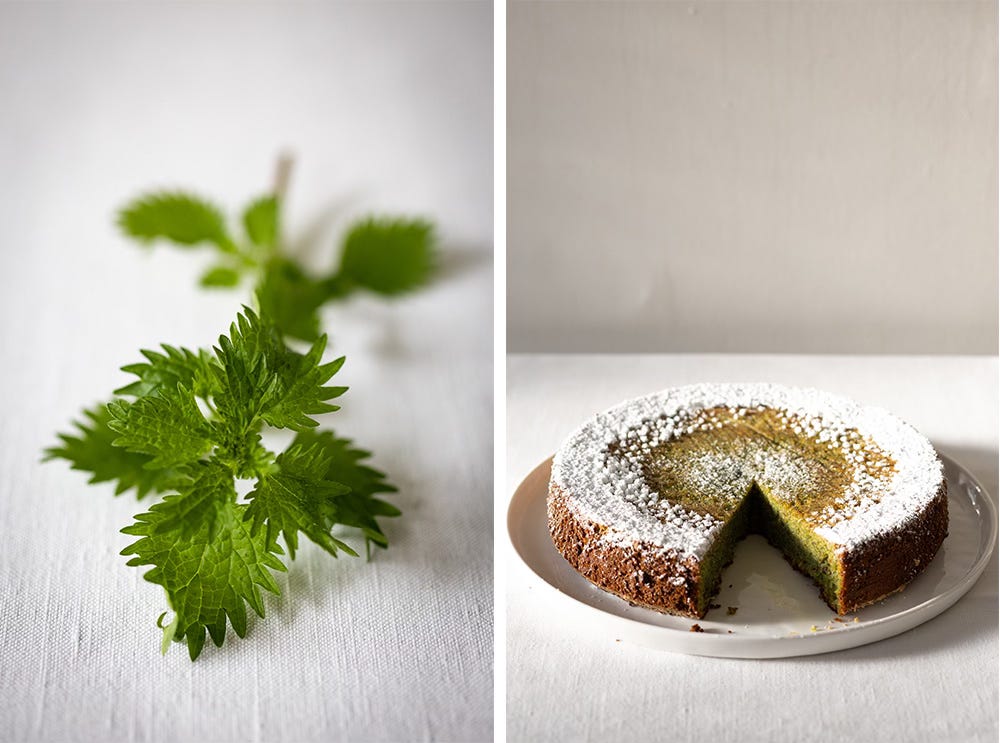Peering over Mel’s shoulder, I was captivated by the image on her phone. We were admiring a slice of cake. Its layers were mossy green, with a vibrancy usually only achieved with industrially produced food dye. Yet the colouring was completely natural, one hundred percent organic, and made from a leaf that grows freely: the stinging nettle.
I knew nettle as a tea, but never as a cake, and somewhere between picking peas and sorrel leaves Mel, the manager at Oranjezicht City Farm, had mentioned she’d tasted one on her visit to Bath City Farm. My godmother was always touting the health benefits of nettle, was this a case of ‘A spoonful of sugar ...’? I was too curious not to try.
Mel kindly supplied a bag bulging with nettles, carefully harvested to avoid getting stung, and I headed back to the kitchen.
Driving home it occurred to me that the last time I’d blanched sprigs of nettles was to lay them on a blistered sourdough pizza with buffalo mozzarella. The wild greens tasted mild, almost nutty, once cooked, which is why they paired with the delicate, milky cheese without overpowering it. This plant, for all its burn, is relatively shy in flavour.
So, it has two things going for it, an intensity of colour but a reticence in flavour, which is precisely why it works as a colouring: It doesn’t alter the cake. Adding a paste of blanched and pureed nettle leaves to a standard vanilla sponge worked first bake. It had a respectable rise and looked golden brown on the outside, but inside it was a grassy meadow green.
I thought of my godmother and her beloved Wiesen (meadows), which inspired Spring Meadow Cupcakes finished with a colourful mix of lilac Alyssum and cerise Pinks from the farm. And seeing a cluster of Spring Snowflakes (which until recently I called Snowdrops) had me imagining them pushing up through snow as a sign of the green to come.
That cake stayed in my imagination though, because while there are many edible flowers, Spring Snowflakes are not among them. (So please don’t decorate with them, the image above is purely conceptual.)
For the workshop I baked an almond version with a Spanish-style cake by Claudia Roden as the foundation and, in the final analysis, the wholesomeness of the nuts and the extension of their flavour in the nettle tipped it as the favourite. So that’s shared below, and it works well both as an iced layer cake or halved in quantity and baked as a single to be dusted with icing sugar.
There’s a certain surprise and delight in cutting through white icing to find a green cake below – Brandon said he was half expecting to taste mint. And although I can’t vouch for it having any health-giving powers, it may win over a child (or inner child) without subjecting them to factory-made food dye.
To see the Spring Meadow Cupcakes, as well as both an iced and sugar-dusted version of the almond nettle cake, click here to watch a reel of the workshop.
Nettle cake
Generally, 50g blanched, pureed, and strained nettle leaves was added to one quantity of cake batter (one cup of butter, two cups of sugar, three cups of flour, four eggs).
Wear gloves when harvesting stinging nettles and use tongs when handling in the kitchen. Wash the nettles by submerging them in a large bowl of water and agitate to dislodge any dirt or dust. Allow it to settle, remove the nettles from the water and transfer to a colander.
To cook, bring a large pot of water to a rolling boil. Using tongs, add a few sprigs of nettles and submerge. The amount of nettle shouldn’t stop the boil completely but, if necessary, replace the lid to bring the water back up to heat. Cook for 30 seconds, transfer to a colander. Remove the nettle leaves, transfer to the jug of a handheld stick blender, press out and pour off any excess water and blend until smooth. Push through a sieve to remove any fibrous bits, leaving a smooth paste.
Preheat the oven to 175°C with the rack in the middle. Butter two 20cm cake pans and line the base of each with baking paper. Separate 375g (around six) eggs, adding the whites to a clean, dry bowl and the yolks to the bowl of a standing mixer. Add 250g caster sugar to the eggs and beat until it looks pale and thick and floppy. Gently mix in 160g ground almonds, the microplaned zest of one lemon, and 50g nettle puree until well combined.
Whisk the egg whites until soft peaks form. Fold a third into the egg yolk mixture to lighten it, and then gently but firmly fold in the remaining egg whites so it is well combined but none of the air is knocked out. Divide the cake batter evenly between the two cake tins. Bake for 20 to 25 minutes or until golden brown and skewer comes out clean. Cool on a rack, run a spatula around the edges of the tin, invert and remove the baking paper. To keep the focus purely on the cake and its the ingredients, serve with a light dusting of icing sugar.
Updated 4 July 2024.




